Amazing Artisan Bread for 40 Cents a Loaf - No Kneading, No Fussing, No Kidding
 February 26, 2010
February 26, 2010 Update: If you're interested, I've written an update on this technique here.
What if I told you that instead of buying bakery bread for four or five dollars a loaf, you could make delicious handmade bread whenever you wanted, at a fraction of the cost and it is so easy a kid could do it? Well, read on because this method of making artisan bread at home will change your life.
You can make incredible bread without having to do all the usual time consuming tasks of breadmaking :
- no need to make a new batch of dough every time you want bread
- no need to proof yeast
- no need to make starters or prefermented dough
- no kneading!
In the last few years, several methods for making easy no-knead bread doughs have crept up on the internet and gained popularity. Among the most popular have been Jim Leahy's No-Knead Bread and Jeff Hertzberg and Zoe Francois' Artisan Bread in Five Minutes a Day. These breads drastically cut down the amount of time and work that it was always assumed had to go into artisan bread making. Even the Zen Master of bread making, Peter Reinhart, has jumped onto the bandwagon, admitting that these no knead methods have made him rethink everything he knew about breadmaking:
"The results have forced me to reconsider all of the premises I once held sacrosanct".
So what is going on here?
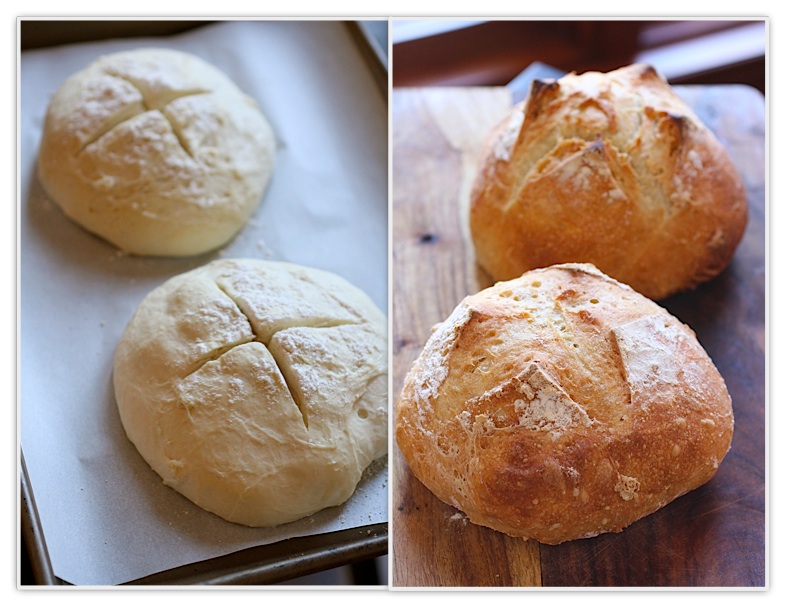
Boules Rising and Boules after Baking
The key is mixing up a high moisture, or "slack" dough, and letting it do a long fermentation in the refrigerator. It's long been known that a long fermentation contributes flavor to dough but it seems it also develops gluten and eliminates the step of kneading. The advantage in using refrigeration is that you can control the fermentation and you can make up a large batch of dough, enough for four loaves, and keep it in the fridge. If you make a very wet dough, it will be able to last in the refrigerator a long time, gaining flavor as it ferments and allowing you to make bread whenever you decide. This is not to say there is not a place for multi-stage, time-consuming bread making techniques which require 15 minutes of kneading - I love making my homemade focaccia, which takes three rises every time I make a batch. But this bread is absolutely a no-brainer. You mix up a big batch of dough in one container, a process which takes only a couple of minutes (remember, there is no proofing of yeast or starters to make). When you want bread, you cut off a hunk of dough and shape it. You can make various sizes and shapes: boules, batards, rolls or baguettes. It's just so convenient and makes such a beautiful bread with a crackly crust, you won't believe it. I've even shaped the dough into rolls. Peter Reinhart points out that the home baker has an advantage over the commercial baker with this technique - the commercial bakery does not have the refrigeration space to use a method like this. As a home baker, we can make up small batches of dough, refrigerate it and enjoy fresh bread whenever we want it. If you are buying fresh bread three times a week at $4.00 per loaf, you are spending about $50 a month on bread! This bread is only about 40 cents a loaf to make. And, since bread is best the day it is made, you don't have to drive to the grocery/bakery to get it every time you want a loaf.
To see how easy it is to get a loaf ready, you can watch me form a loaf in about 30 seconds:
This bread is very versatile, also. In both Peter Reinhart's book and Jeff Hertzberg and Zoe Francois' book, they give you many variations of breads made with the master bread recipe in each book. You can make whole wheat breads, cheese breads, herb breads, breads stuffed with sun dried tomatoes, Challah, Semolina Bread and on and on. Jeff Hertzberg and Zoe Francois have come out with another book, "Healthy Breads in Five Minutes a Day", for people who would like more whole grain recipes and gluten free breads. This is a great book, too, and has lots of wonderful ideas in it. I have all three books and strongly recommend them if you want to try easy bread making. It's nice to be able to make bread whenever the whim hits you - I have several types of doughs in my refrigerator, happily fermenting away.
In these recipes, instant yeast is used, which eliminates the need for "proofing" the yeast. Everything is simply mixed together. If you are interested in learning more about yeast, my recent "Yeast Explained" post may be of interest to you. Instant yeast is sometimes labeled "fast acting yeast" and is sold under the names of "Rapid Rise" and "Quick Rise" yeast. Also, Bread Machine yeast is simply instant yeast. I like to buy my yeast in the little jars instead of the packets because I can use only as much as I need out of the jar and it tends to be cheaper.
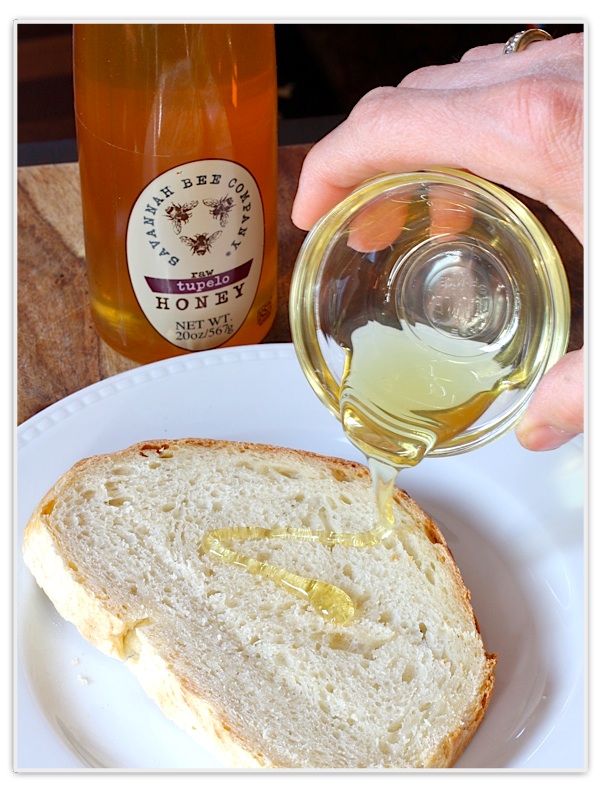
One way of letting the dough rest and rise is to place it on a pizza peel, dusted with some cornmeal. This works well when we make pizzas and pop them right into the oven. However, for this the bread seems to stick because you have to let it sit so long on the pizza peel and rest. So I place a small square of parchment paper on the pizza peel and put the dough right on that. When I slide it into the oven, it goes in along with the parchment paper and bakes up beautifully. If you want an extra crispy crust, just remove the parchment paper halfway through the baking time and return the bread to the pizza stone - this is what I do.
The dough can be stored in any plastic container with a lid or a bowl with plastic wrap placed over it. You want the gases to be able to escape as the dough rises, though - so wrap the plastic wrap over the bowl tightly and then puncture a little hole in the top. It is nice to have a dedicated plastic container, though, in the fridge for your dough, because you are going to just keep it in there all the time. Although these containers are recommended by the authors and the King Arthur Flour website has these nice dough rising buckets, I bought a square plastic-lidded container at my local grocery store because I thought it fit in my fridge better. You can see it in the photos below. I place the lid on tightly, but I punched a small hole in the top. This is important to do.
So get out a bowl if you don't have a plastic container, mix up a batch of dough and have your first loaf tomorrow. You won't believe it.
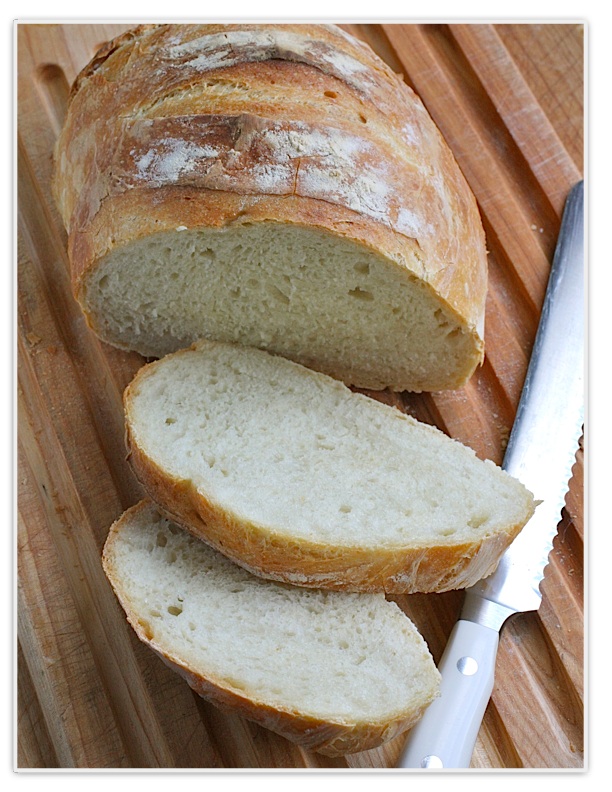
No Knead Artisan Bread
adapted from Artisan Bread in Five Minutes a Day
for a printable recipe, click here
makes four 1 pound loaves.
Ingredients:
- 3 cups lukewarm water
- 1½ tablespoons granulated fast acting (instant) yeast (2 packets)
- 1½ tablespoons kosher or other coarse salt
- 6½ cups unsifted, unbleached all purpose white flour*
(My favorite way to make this bread now is to use half bread flour, half all-purpose flour and throw in ½ cup wheat bran into the dough.)
*After baking, if your bread is gummy on the inside, try either increasing the amount of flour by ½ cup and/or increasing the baking time by 10 minutes.
Instructions:
Mixing and Storing the Dough
1. Warm the water slightly. It should feel just a little warmer than body temperature, about 100 degrees F. Warm water will rise the dough to the right point for storage in about 2 hours.
2. Add yeast and salt to the water in a 5 quart bowl or a plastic container with a lid.
3. Mix in the flour - kneading is unnecessary. (Note: I dump all this in my KitchenAid mixer, let it mix it for just about 10 seconds and then put it in the plastic container. I just find it easier to let the mixer do this part). Add all of the flour at once, measuring the flour by scooping it and leveling it off with a knife. Mix with a wooden spoon - do not knead. You're finished when everything is uniformly moist, without dry patches. This step is done in a matter of minutes. The dough should be wet and loose.
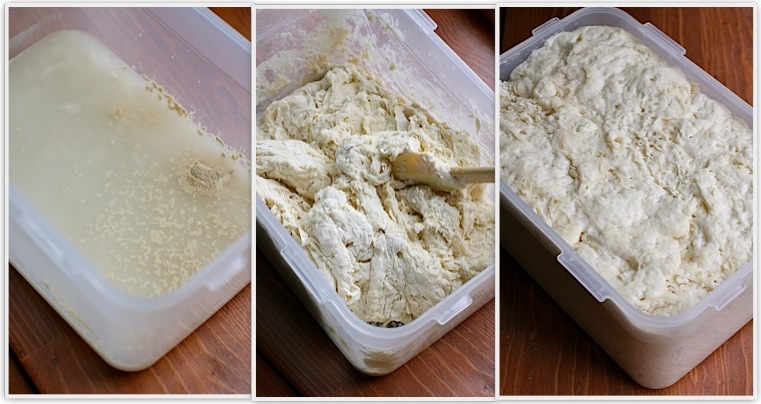
4. Allow to rise. Cover with a lid (not airtight). Lidded plastic buckets designed for dough storage can be purchased many places. (I used a plastic square food storage container I got at my local grocery store. I now use a Rubbermaid 21-cup Dry Food Container. I punched a hole in the top). You want the gases to be able to escape a little. Allow the mixture to rise at room temperature until it begins to collapse (or at least flattens on top), about two hours. Longer rising times will not hurt your dough. You can use a portion of the dough any time after this period. Fully refrigerated wet dough is less sticky and is easier to work with than dough at room temperature. So, the first time you try this method, it's best to refrigerate the dough overnight (or at least 3 hours) before shaping a loaf.
Baking
5. Shape your loaf. Place a piece of baking parchment paper on a pizza peel (don't have a pizza peel - use an unrimmed baking sheet or turn a rimmed baking sheet upside down). Sprinkle the surface of your dough in the container with flour. Pull up and cut off about a 1-pound piece of dough (about the size of a grapefruit), using scissors or a serrated knife. Gently stretch the surface of the dough around to the bottom on all four sides, rotating the ball as you go. Dust your hands with flour if you need to. This is just to prevent sticking - you don't want to incorporate the flour into the dough. The top of the dough should be smooth - the object here is to create a "gluten cloak" or "surface tension". It doesn't matter what the bottom looks like, but you need to have a smooth, tight top. This whole step should take about 30 seconds! Place the dough onto your parchment paper.
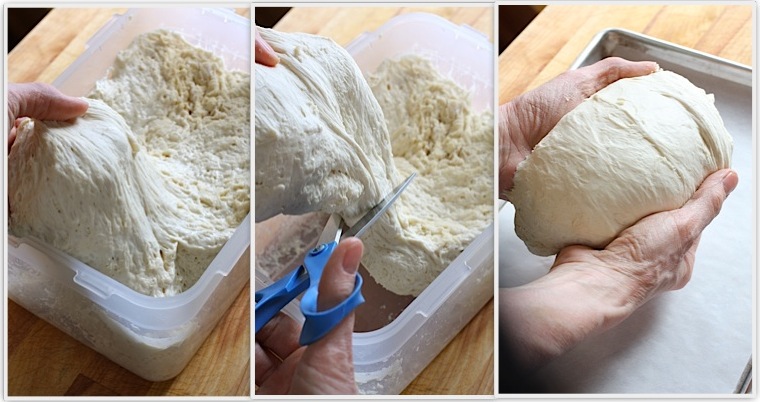
6. Let the loaf rise for about 30 - 40 minutes (it does not need to be covered). If it doesn't look like it has risen much, don't worry - it will in the oven. This is called "oven spring".
7. Preheat a baking stone on the middle rack in the oven for at least 20 minutes at 450 degrees F. Place an empty rimmed metal baking pan or broiler pan on a rack below the baking stone. This pan is for holding water for steam in the baking step. (If you don't have a baking stone, you can use a baking sheet, but you will not get the crisp crust on the bottom. You will still have a great loaf of bread. Baking stones are cheap and easy to find - Target carries them - and are a must for making pizzas, so go out and get one as soon as you can.)
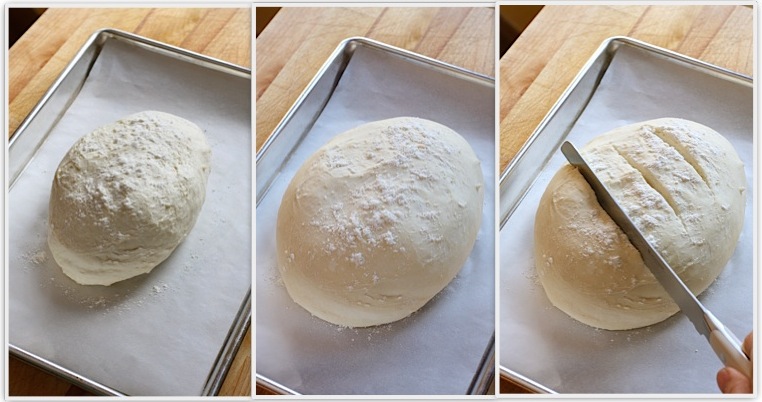
8. Dust the loaf with a little flour and slash the top with a knife. This slashing is necessary to release some of the trapped gas, which can deform your bread. It also makes the top of your bread look pretty - you can slash the bread in a tic tac toe pattern, a cross, or just parallel slashes. You need a very sharp knife or a razor blade - you don't want the blade to drag across the dough and pull it. As the bread bakes, this area opens and is known as "the bloom". Remember to score the loaves right before baking.
9. Bake. Set a cup of water next to your oven.* Slide the bread (including the parchment paper) right onto the hot baking stone. Quickly pour the water right into the pan underneath the baking stone and close the oven door. This creates the necessary steam to make a nice crisp crust on the bread. Bake at 450 F for about 30 - 35 minutes, depending on the size of your loaf. Make sure the crust is a deep golden brown. When you remove the loaf from the oven, you will hear it crackle for a while. In baking terms, this is called "sing" and it is exactly what you want.
* update: I have recently begun skipping this step with the water. I believe it caused my oven window to eventually crack and I have found that my bread is still great even without the water. If you want an extra crispy crust, though, it is worth doing once in a while
10. Cool. Allow the bread to cool for the best flavor and texture. It's tempting to eat it when it's warm, and that's fine, but the texture is better after the bread has cooled.
11. Store the remaining dough in the refrigerator in your lidded (with a hole punched in the top) container and use for up to 14 days. Every day your bread will improve in flavor. Cut off and shape more loaves as you need them. When your dough is gone, don't clean the container. Go ahead and mix another batch - the remaining bits of dough will contribute flavor to the next batch, much like a sourdough starter does!
Bread is best eaten the day it is baked. Leftover baked bread is best stored at room temperature, unwrapped. Simply place the cut side of the bread on plate or counter. If your bread is gummy on the inside, try either increasing the amount of flour by 1/4 cup and/or increasing the baking time by 5-10 minutes.
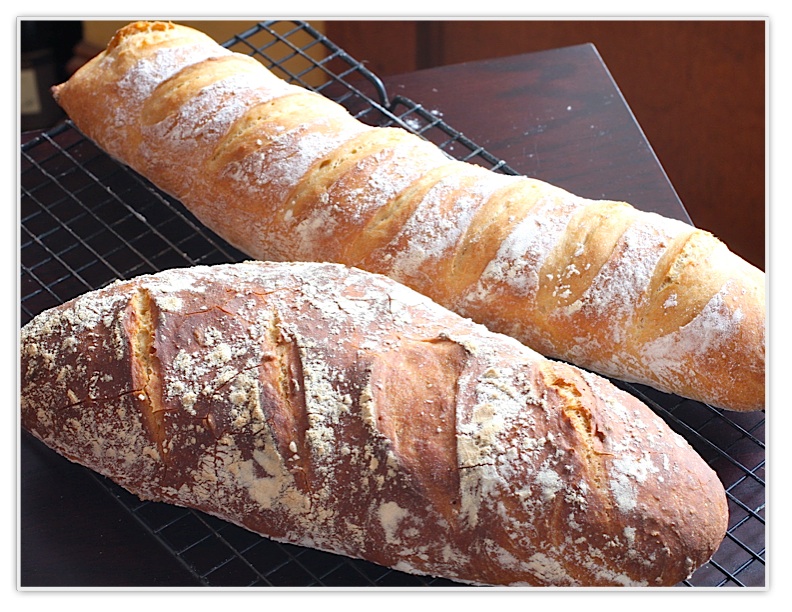
Check out the Artisan Bread in Five Minutes a Day website - Jeff and Zoe have great tips and recipes over there.

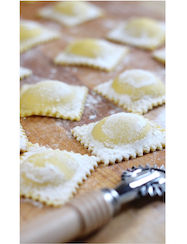
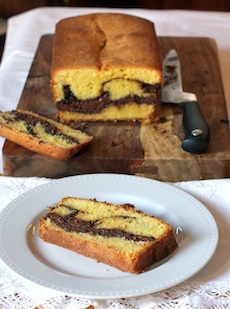
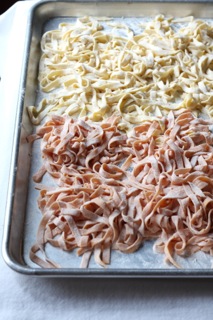
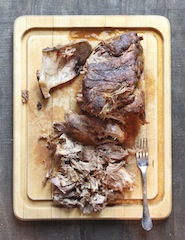
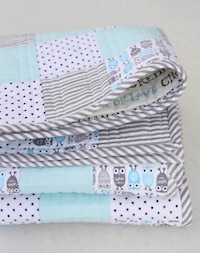
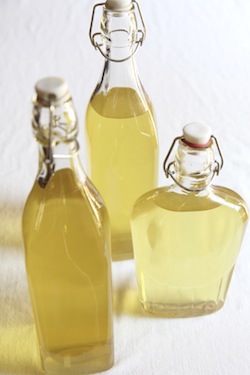
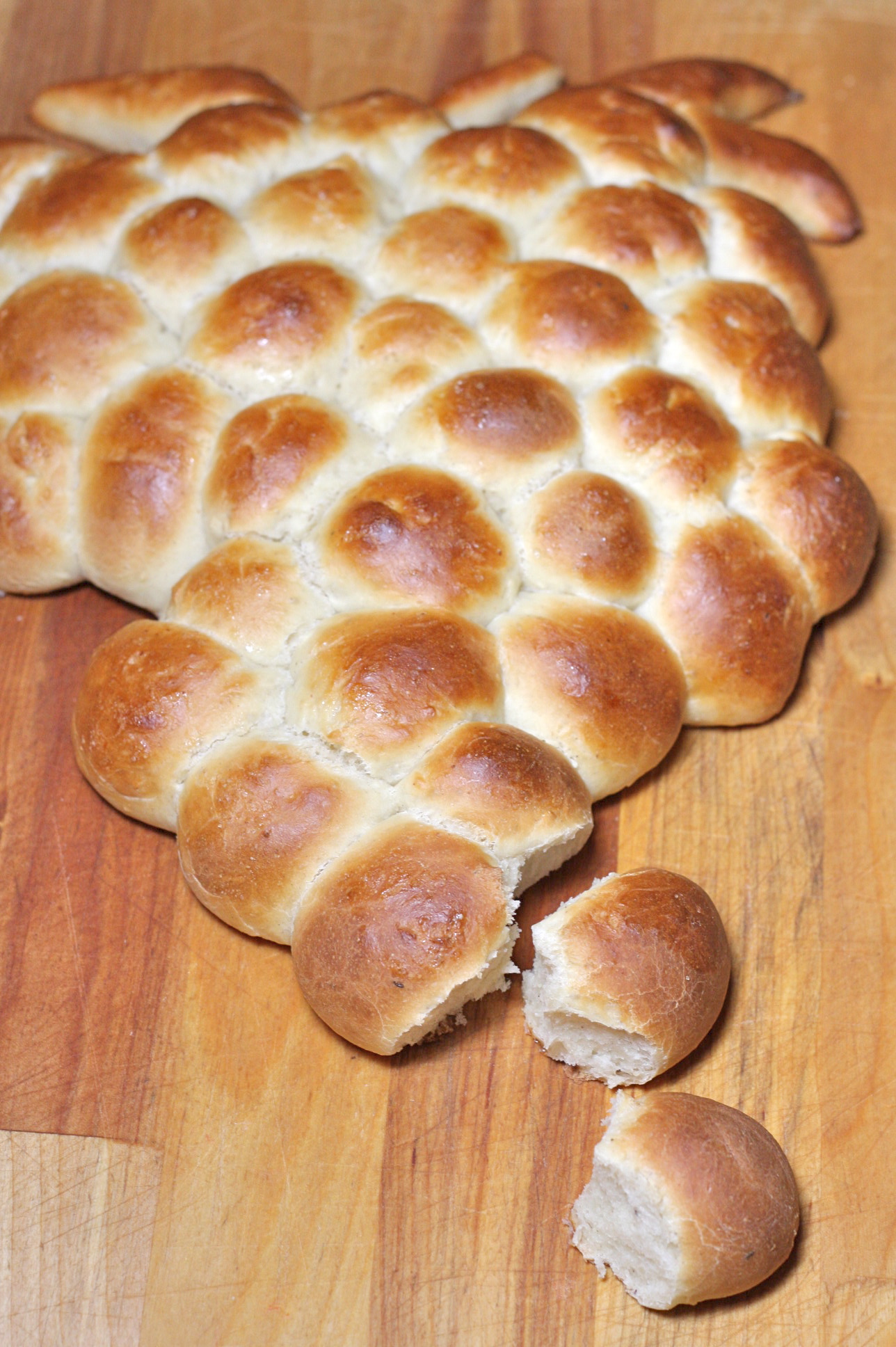
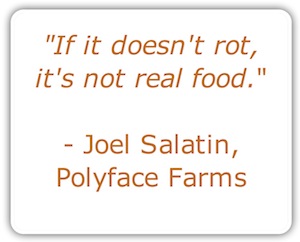
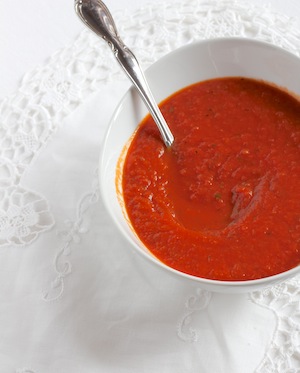
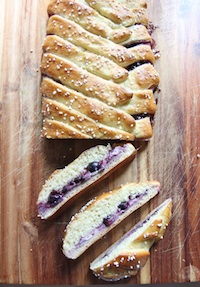
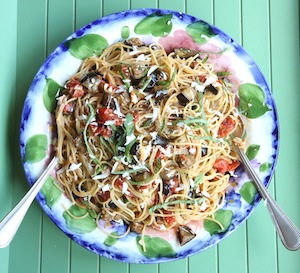
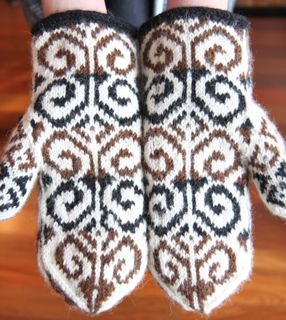
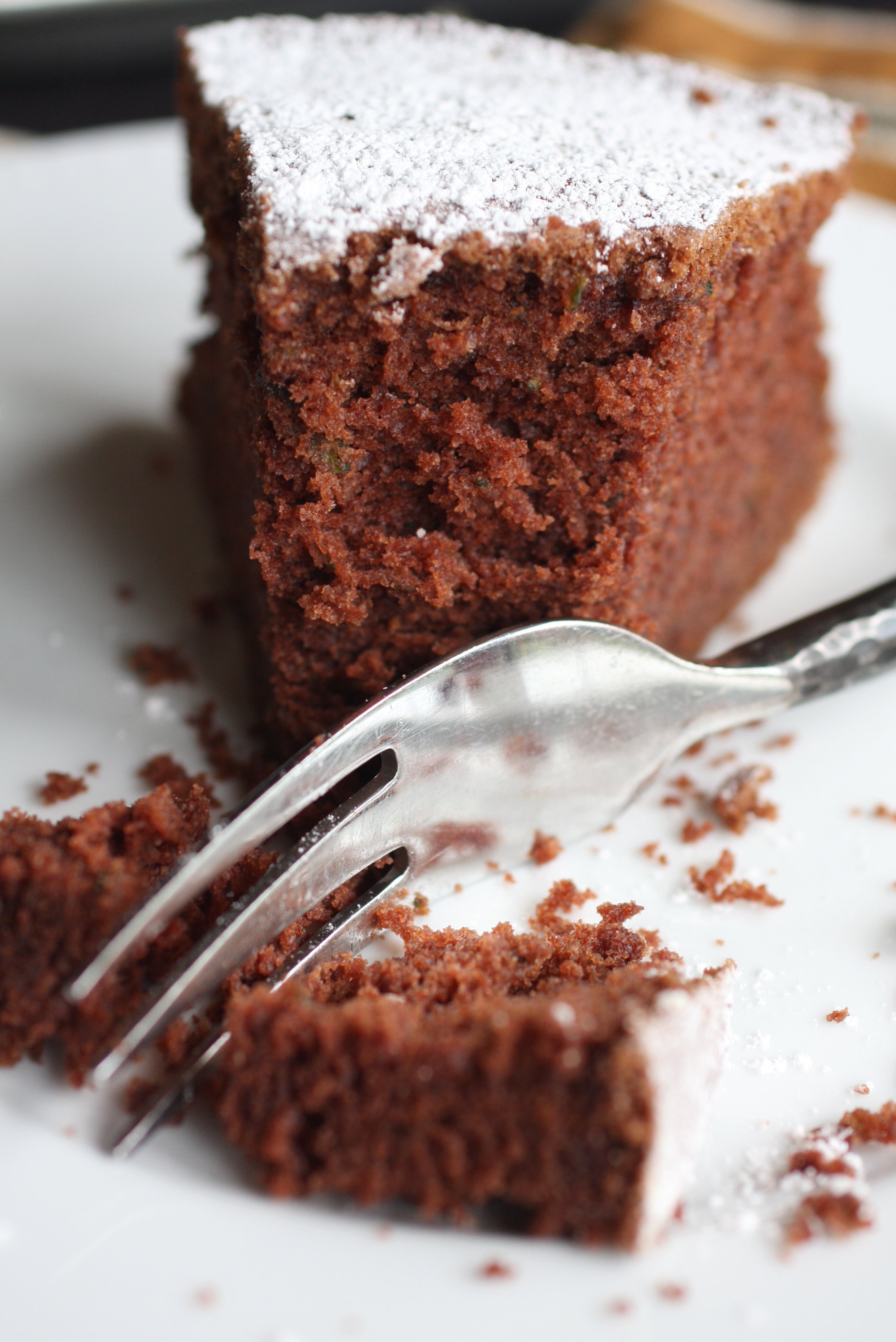


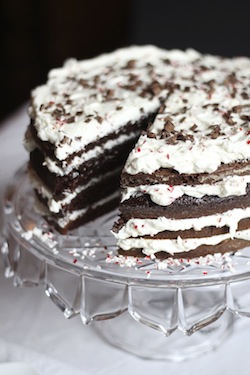

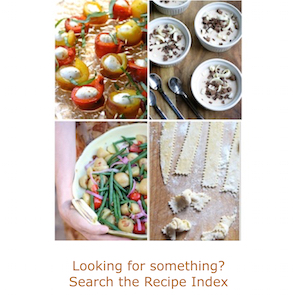
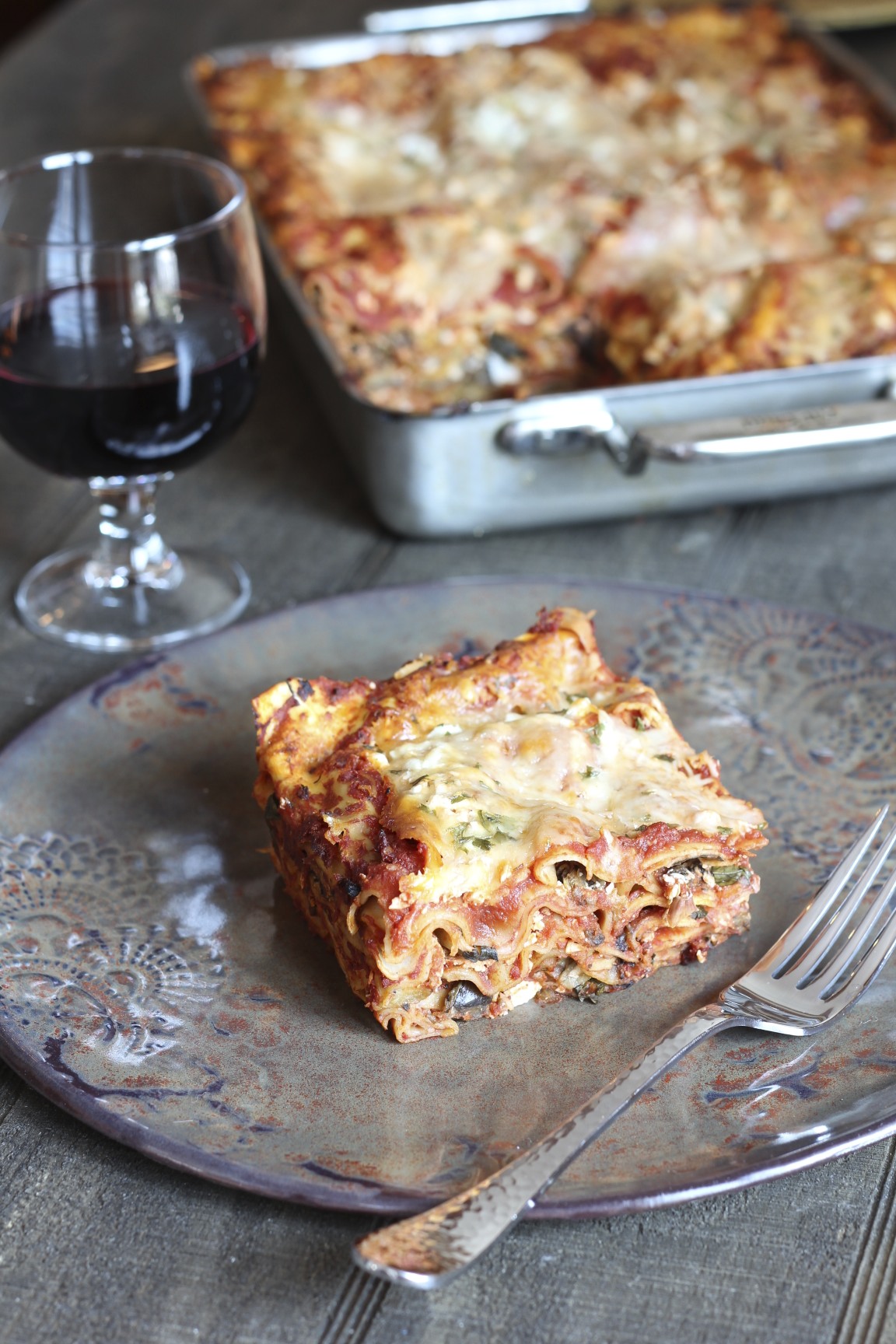
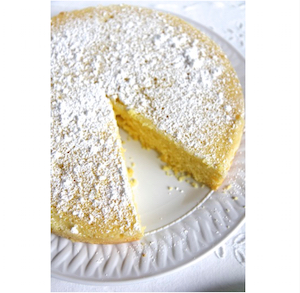
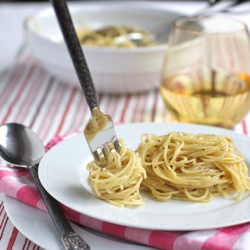
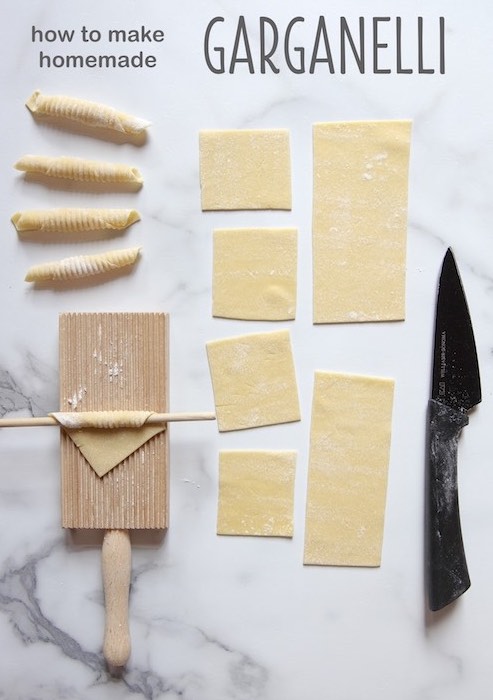
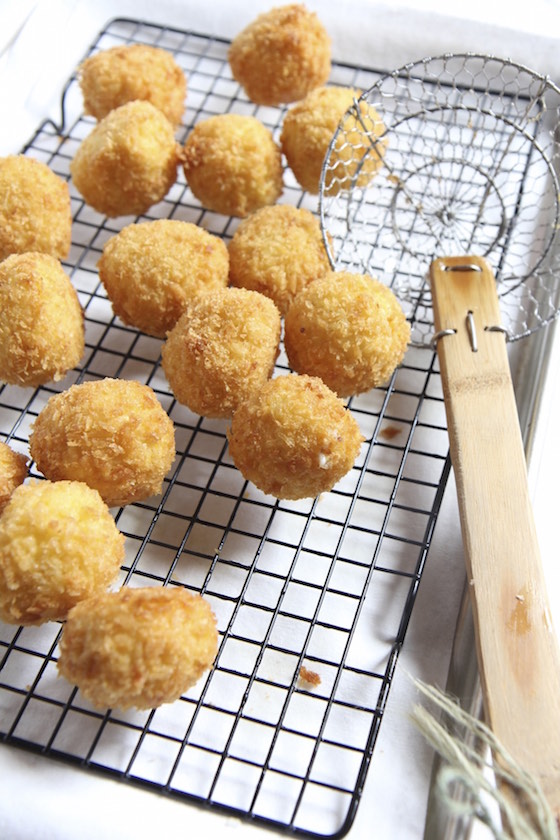



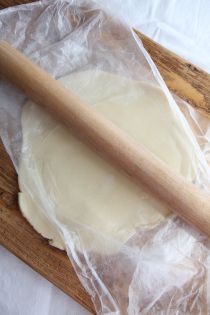












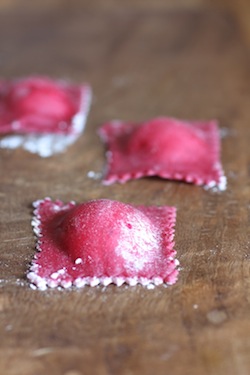

Reader Comments (468)
From The Italian Dish:
Susan: I make rolls out of this dough all the time. If you make fairly small rolls, I bake them for 20 minutes. You will have to experiment a little with the size and baking time. Basically, bake them until the crust is a deep golden brown.
As for your starter dough, there are tons of recipes online for using starter doughs. There's a lot of great information out there - just google it.
Mmmm, that looks delicious! I can't wait to try it; thanks for the great tutorial!
I made this bread this afternoon and it looks just like the pictures! Thanks so much for a great recipe.
I've been having some issues with this recipe. It seems no matter what I do, my bread bursts on one side or the other. I've tried cutting it deeper on the top and rotating it during baking (I thought may be it was heating unevenly) but it still happens every time. The bread is delicious and it comes out fine otherwise, but it's just ugly.
thanks for this recipe! we both love this bread! we use it for everything, garlic bread, sandwiches, croutons..etc..
i made this with what i had on hand-whole wheat flour and active dry yeast (not instant) and it was pretty awful. then i made it with ap flour and instant yeast and it's nothing short of amazing. thanks so much for the great recipe!
also, in case anyone else out there is a plastic-phobe i was able to fit the full recipe in a 2.75 qt glass baking dish (but 3 qt would probably be a bit better).
Thank you, thank you, thank you for this. I love making bread and am in a sublet at the moment - without much to work with, including counter space. This recipe means I'll be making bread tomorrow!!
I'm so thrilled.
Love this site and made this bread yesterday. I was so good and super easy. I just had one problem, it didn't get as golden brown as shown in your pictures. It was still very crunchy. What do you think might have gone wrong?
I've made this bread now 5 times. I've learned you cannot bake it in a convection oven. I've learned that the bread takes about 35 minutes at least to bake. But for some reason, every loaf I bake doesn't get cooked throughly through the middle of the loaf. It always looks to be a bit "gummy" in the middle. Does anyone have any suggestions as to what I'm doing wrong? 90% of the bread looks great inside but there's always a doughy spot that looks uncooked. Anyone???
From The Italian Dish:
Annette: Just bake it a little longer until it is a deep golden brown.
John: I've been experimenting with this recipe myself for a long time now. I have found that if your bread is turning out gummy, there are three things you can do. 1) make sure you thoroughly let it cool. 2) Cook it about 10 minutes longer 3) Don't make such a wet dough - add about 1/4 cup more flour to your next batch of dough and see how the bread turns out. Every oven and kitchen is different. I do all three of these things and my bread is never really gummy anymore, it's just perfect. I think adding a little bit extra flour to the dough really helps. Good luck and let me know how you do.
Thanks for the input. I've definitely cooked it much longer and that has helped. I also agree with the letting it cool part. And I've learned the less water in the pan underneath means a crispier crust. About 3/4 cup seems best. The more water I've added the chewier the crust. I think your suggestion about the dough is probably the one to follow. I was worried about the dough being too dry but the center came out better than previous batches. A little more flour is the next attempt! Thanks again, John
Truly amazing!!! We've enjoyed it so much that we couldn't stop eating... Thanks a lot for this wonderfull recipe.
I made the bread yesterday and I cooked it this morning for breakfast. It was delicious!!!
After the first 20 min I took out the recipient with water from the oven and let it bake for ca another 20 min, so it was really crunchy and well baked (fluffy inside, hard outside), with a little gummy texture inside which I like ´cause it reminds me the artisan european baguette.
Just baked a loaf this afternoon. I was so good! I don't have a pizza stone, but I just baked it on a cookie sheet with some parchment paper and it turned out great! Hubby loves it. The crust is crunchy but the inside is so soft and chewy. It's great! Easiest bread I've ever made, but very sticky dough. I had a hard time shaping it, but it turned out "rustic" looking. Made fantastic garlic bread. I'm going to give this recipe to my mother in law. She can't make bread anymore because she has bad wrists and can't kneed.
From The Italian Dish:
Naomi: So glad you loved the bread. The dough is much easier to shape after it has chilled in the fridge overnight, so try to make sure to do that before shaping the loaf.
YUM!
I've always been scared of yeast, so i have never attempted bread before. But last night i bit the bullet, made the dough (which was super easy - even for a first timer!), let is rise for about three hours on a warm surface (i just sat the container the top of my electric cooker which was still a bit warm from my dinner). Then i refrigerated over night, formed the shape in the morning, let it rise a bit more (just as instructed above) then baked it :) fresh crusty bread in the morning? doesn't get much better, i'm pretty sure!
thankyou, i'll be making again and again :) :)
Thank you so much! I've been looking for some good rustic, artisan bread recipes hoping to recreate the wonderful breads I had in Rome this past Christmas. I will definitely give yours a try! One bread I've not been able to find a recipe for was an extremely thin, flat bread, very crispy and salty, at the Sant'Angelo cafe. It was the best salami sandwich I've ever had! If you have any suggestions, I would greatly appreciate!
Wow! I was so excited to find this blog and this recipe that I made my first batch of dough that very instant. I just finished baking my first loaf and had just a little trouble and am hoping you can advise. Like another poster, I had a problem with one of the sides ripping open, cracking, during baking. I read all of the posts to see if you have answered this question before, but I could not find one that addressed this concern. I think the problem may be in the formation of the smooth gluten cloak. It was smooth, but probably could have been smoother. Thank you so much for this blog! It is amazing! Look forward to hearing back from you.
From The Italian Dish:
Vandera: I'm not sure if this is exactly what you are looking for, but I did write a post for a recipe for crispy herbed flatbread. You can find it here:
http://tinyurl.com/296w6mn
Hope that helps. Of course, you can customize the topping to suit you.
Justin: So glad you made the bread. You know, every once in a while I get a loaf where the side of it pops out or something weird. I have no explanation for the randomness of that. Most of my loaves turn out very pretty, though. Please try again and I bet you will have success. Good luck!
Bread is the staff of life. It is always a pleasure to find great new ways to make it. Thnaks.
Okay, the first time was a failure for me. On several tries, the bread was gummy and not dark like your pretty pics. So, I adjusted the measurements - more flour, used King Arthur's unbleached Bread flour instead of Generic Unbleached Flour, and baked it for 35 minutes. It turned out perfect!! I feel like I am eating real bread from Europe again - fresh and no preservatives!
From The Italian Dish:
C.: So glad you tried again and got it right! It's so worth it. A little extra baking time sometimes helps a lot.
First thanks for posting this! I bet it took a lot of time to write all of this out! Also I had a quick question or two. If you want to add items to the bread like herbs or sun-dried tomatoes or olives, etc. do you add these to the dough before you put it in the fridge or add it to the individual loaves when you are ready to make them? Also, can you use this for a pizza crust? If so, how long do you bake it for? I think you mentioned something above but I don't recall a time. Last question (sorry!!!), can you use this to make filled breads like breads with pesto in them or cheese? Thanks so much! My husband thanks you ahead of time :)
From The Italian Dish:
Sarah:
First of all, if you look at my latest post (July 24th) I have a recipe for pesto bread. It is this bread stuffed with pesto. You can also add 1 cup of finely shredded cheese (like cheddar) to your dough when you make it for cheese bread.
You can add other items like herbs in the dough if you like but you can also add them before you bake the bread. Just experiment. I have not personally used this dough for pizza but I'm sure it would be fine. Just roll out the dough and add your toppings, without letting it rise.
Hope this helps.
Hi, Would this work with whole wheat flour or whole wheat pastry flour? thanks !
I have to be on a low Iodine diet and needed to make my own bread if I wanted to have any so I decided to try this. Holy cow!!! It is awesome!
I made the first few batches with yeast bought from my regular grocery store and it was really good. Then I read about SAS yeast and decided to buy it based on the recommendations of lots of bread baking sites. What a difference in the yield of my bread!! I used to proof my yeast to insure that it was still active, despite the sell by date. You don't need to proof this yeast and it rises so much faster than packaged yeast. I bought it on Amazon.
Thank you for the detailed instructions and the recipe!!!
From The Italian Dish:
Barb: SAF Yeast is Instant Yeast and if you've never used instant yeast, you would be pleasantly surprised at how well it rises. I only use instant yeast and never have to proof it. SAF is the same company as Red Star yeast. They are both great yeasts. If you can buy bulk SAF, it is a cheaper way to go. I'm so glad you like the bread!
This bread is fantastic. I have just come off three weeks rafting on the Grand Canyon, and I made this bread twice in the dutch oven, first as one big loaf, and the second time as dinner rolls. I drilled a tiny hole in the top of a tall lock n' lock container, and made sure the container would be upright for 24 hours. Worked like a charm.
From The Italian Dish:
Thingamababa: I am so impressed! Way to go.
I've just found your blog about easy artisan bread and can't wait to try it. I have a question: is there a variation that uses flours other than white flour - e.g., whole-grain, spelt, etc.? If there is, could you post it? Many thanks again.
From The Italian Dish:
Lorraine: Jeff and Zoe have actually come out with a follow up book called "Healthy Breads in 5 Minutes a Day". They have lots of whole grain recipes using this method. I posted a link to their web site at the bottom of this post. I have made this bread with whole wheat flour. I have also used half whole wheat and half white flour. I have also used "white" whole wheat flour, my favorite. It has just as much fiber as regular whole wheat, but tastes better and rises better. You can use half white whole wheat and half regular AP. If you use all whole wheat flour, add about 1/4 cup of "vital wheat gluten" to your dough so that it will rise better. Also, a little sugar or honey helps - the whole wheat flour will not be as sweet as the white flour. Check out Jeff and Zoe's site for more on whole wheat baking.
This is such a wonderful recipe. Thank you so much for sharing it. I make a batch every Saturday. My family loves it and it is so delicious.
Thanks very much for answering my question so quickly. I appreciate it and will look for the book right away - can't wait to try the recipes.
This looks fantastic and I can't wait to try it! I was wondering (sorry if this is a repeat question, didn't see it in the posts) if other types of flour, such as rice flour, will work? Or is a wheat-based flour necessary for a successful dough?
From The Italian Dish:
Angela: Yes, there is a lot written in the comments about using other flours, but not rice flour. I've never tried that for bread making. I guess do a Google search and see what you find!
Hello there! I have been following your blog for quite a while. It's just so wonderful that even though I haven't tried any recipe, I keep checking :) Thank you very much!
Today finally I take my courage to try this recipe. Needless to say how much I love bread and dream of baking fresh by myself.
Don't know what's going on but... First, I reduced the recipe to half because 6C of flour seems a lot for me. So I put 3 1/4 C flour with 1 1/2C lukewarm water. Then my yeast package is not 1 1/2 tbs but written 2 1/4 tbs. So I adjust accordingly (hopefully). I mix and the mixture seems too hard, not wet and loose. I thought I messed up with measurement so I put more water (about 1/2C) i think, and also nearly the rest of yeast :(( How stupid I am.
I let the dough rise for 2 hours, put in the fridge over night!
This morning... the dough is so wet that I can't form at all :(( I stil try my best though. Now one in the oven. The rest of the dough I put a little more flour and put back to fridge.
Now I keep my finger crossed!
I don't know what I should hope for because obviously I messed up with your wonderful recipe! :(
Very sorry for my super loooong message ^^
I don't know if you wanna be updated but here's my mess-up result ^^ The first loaf (no time in fridge) was very crispy outside and I love that. But the inside was a little chewy. As you said, I think baking a little longer can help. The second loaf: the dough is still so wet to form :(( Again, very crispy outside but inside seems better. However, this time, smell of the yeast (due to fermentation i guess) is so strong :( What did I do?
Overall, I want to try more. Hopefully next time it will be better. Thank you again,
I have tried this, and while the flavor was good, my loaf is flat instead of round. It raised great in the bowl before I put it in the fridge. I've made two loaves out of it so far, and both stayed flat.
I had a hard time shaping it because it still seemed too "wet". Could that be the problem?
From The Italian Dish:
Shirlely: I'm surprised your loaf stayed flat, especially because it rose in the bowl. Was the oven properly preheated? In your next batch of dough, add about 1/4 cup more flour. Make sure the dough is refrigerated at least overnight - it's so much easier to work with. Really pinch the dough underneath itself to create the tension on top. Try again and let me know! Good luck!
There is nothing better than fresh baked bread. I cannot wait to do this! What a great post and blog!
Hi! This recipe was such an amazing find, I was searching for an easy way to bake bread myself because I live alone and can never finish even half of the $4 store bought loaves and they get very stale very fast. I couldn't believe how easy this recipe looked and had to try it the very next day! I was very impressed by how short it takes to bake, and how delicious it is! I no longer have the going stale problem as my entire loaf disappears within minutes of baking ;) I bought the healthy bread book and I'm looking forward to making these breads more and more. Thanks for sharing this recipe!
Just one question: I'm Turkish (living in the USA) and in Turkey we have very fluffy bread with a crispy outside but very very soft inside with lots of holes. This bread, while delicious, is very dense. I was wondering if you knew of a way to make the bread fluffier? I've never made bread before, don't know if it's possible or not with this "instant" method.
OMG!!! Im a crazy fan for home made bread but never had the corague to make any....but I made this recipe and everyone that I shared the bread with felt in love...now they think im such a great cook!!lol...THANK YOU SO MUCH!!!!...can I make it with weaht flour?...
From The Italian Dish:
Merve: I'm not sure how to get more holes in the loaf. I'm glad you like the bread. It's easy just to form a small loaf for one person.
Saskya: Yes,there's a lot of discussion about using whole wheat flours in the comments. My favorite way is to use half whole wheat white flour and half regular AP flour. If you use all whole wheat flour, the loaf won't rise well - you need to add about 1/4 cup of Vital Wheat Gluten to the dough. Hope this helps.
This was my first time using the no knead bread recipe. I have been making French bread and Sour Dough for years. I happened upon this site and couldn't wait to try it. So easy and so tasty. Loved the flavor and texture. If you have never made bread before you will quickly go from Amateur to Professional in short order. Thank you so much for your blog. I will try other flavors and this will stand proudly next to my sour dough.
I just made this bread and it turned out fabulous! I am so excited! I've been wanting to learn to make this bread for years and no one could tell me how. And to think that it is so easy! I am smitten!!!
just made a batch of bread dough. I will bake it tomorrow. I am not to sure about the stone I have never used one. I do own one. I can’t wait.
This Bread was absolutely amazing. I made 1/2 the amount to try it because I've been sticking with Sourdough but OMG, the crust was just awesome. Already started another Batch, full amount this time. It tastes just like it does back Home in Germany...Thank you for sharing the recipe with us.
So delicious!! I made this with the butternut & acorn squash soup recipe on allrecipes.com. Love the crusty outside of the bread!
I have a quick question: I just made the last 2 loaves from my third batch and noticed that the dough smells a little like acetone, kind of like young Sourdough. Is that normal or do I have to throw them out?